Molecular basis for Rab prenylation
- PMID: 10893259
- PMCID: PMC2185574
- DOI: 10.1083/jcb.150.1.89
Molecular basis for Rab prenylation
Abstract
Rab escort proteins (REP) 1 and 2 are closely related mammalian proteins required for prenylation of newly synthesized Rab GTPases by the cytosolic heterodimeric Rab geranylgeranyl transferase II complex (RabGG transferase). REP1 in mammalian cells is the product of the choroideremia gene (CHM). CHM/REP1 deficiency in inherited disease leads to degeneration of retinal pigmented epithelium and loss of vision. We now show that amino acid residues required for Rab recognition are critical for function of the yeast REP homologue Mrs6p, an essential protein that shows 50% homology to mammalian REPs. Mutant Mrs6p unable to bind Rabs failed to complement growth of a mrs6Delta null strain and were found to be dominant inhibitors of growth in a wild-type MRS6 strain. Mutants were identified that did not affect Rab binding, yet prevented prenylation in vitro and failed to support growth of the mrs6Delta null strain. These results suggest that in the absence of Rab binding, REP interaction with RabGG transferase is maintained through Rab-independent binding sites, providing a molecular explanation for the kinetic properties of Rab prenylation in vitro. Analysis of the effects of thermoreversible temperature-sensitive (mrs6(ts)) mutants on vesicular traffic in vivo showed prenylation activity is only transiently required to maintain normal growth, a result promising for therapeutic approaches to disease.
Figures

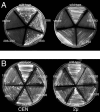

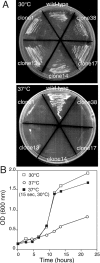

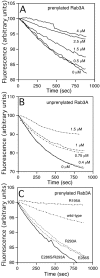
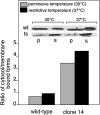
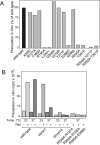
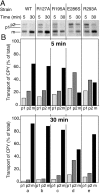
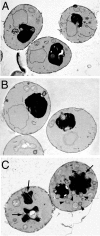
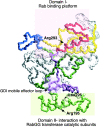
Similar articles
-
Molecular evolution of the Rab-escort-protein/guanine-nucleotide-dissociation-inhibitor superfamily.Mol Biol Cell. 2003 Sep;14(9):3857-67. doi: 10.1091/e03-04-0227. Epub 2003 May 29. Mol Biol Cell. 2003. PMID: 12972569 Free PMC article.
-
Amino- and carboxy-terminal domains of the yeast Rab escort protein are both required for binding of Ypt small G proteins.Mol Biol Cell. 1996 Oct;7(10):1521-33. doi: 10.1091/mbc.7.10.1521. Mol Biol Cell. 1996. PMID: 8898359 Free PMC article.
-
A specific feature of the angiosperm Rab escort protein (REP) and evolution of the REP/GDI superfamily.J Mol Biol. 2005 May 20;348(5):1299-313. doi: 10.1016/j.jmb.2005.02.002. Epub 2005 Feb 23. J Mol Biol. 2005. PMID: 15854662
-
Prenylation of Rab GTPases: molecular mechanisms and involvement in genetic disease.FEBS Lett. 2001 Jun 8;498(2-3):197-200. doi: 10.1016/s0014-5793(01)02483-8. FEBS Lett. 2001. PMID: 11412856 Review.
-
Rab escort protein 1 (REP1) in intracellular traffic: a functional and pathophysiological overview.Ophthalmic Genet. 2004 Jun;25(2):101-10. doi: 10.1080/13816810490514333. Ophthalmic Genet. 2004. PMID: 15370541 Review.
Cited by
-
Mutation of the zebrafish choroideremia gene encoding Rab escort protein 1 devastates hair cells.Proc Natl Acad Sci U S A. 2004 Feb 24;101(8):2572-7. doi: 10.1073/pnas.0308474100. Proc Natl Acad Sci U S A. 2004. PMID: 14983050 Free PMC article.
-
Cell cycle-dependent phosphorylation of Sec4p controls membrane deposition during cytokinesis.J Cell Biol. 2016 Sep 12;214(6):691-703. doi: 10.1083/jcb.201602038. J Cell Biol. 2016. PMID: 27621363 Free PMC article.
-
Molecular evolution of the Rab-escort-protein/guanine-nucleotide-dissociation-inhibitor superfamily.Mol Biol Cell. 2003 Sep;14(9):3857-67. doi: 10.1091/e03-04-0227. Epub 2003 May 29. Mol Biol Cell. 2003. PMID: 12972569 Free PMC article.
-
GPCRs, G Proteins, and Their Impact on β-cell Function.Compr Physiol. 2020 Mar 12;10(2):453-490. doi: 10.1002/cphy.c190028. Compr Physiol. 2020. PMID: 32163203 Free PMC article. Review.
-
Choroideremia in a woman with ectodermal dysplasia and complex translocations involving chromosomes X, 1, and 3.Ophthalmic Genet. 2010 Dec;31(4):178-82. doi: 10.3109/13816810.2010.497529. Ophthalmic Genet. 2010. PMID: 21067479 Free PMC article.
References
-
- Alexandrov K., Simon I., Yurchenko V., Iakovenko A., Rostkova E., Scheidig A.J., Goody R.S. Characterization of the ternary complex between Rab7, REP-1 and Rab geranylgeranyl transferase. Eur. J. Biochem. 1999;265:160–170. - PubMed
-
- Anant J.S., Desnoyers L., Machius M., Demeler B., Hansen J.C., Westover K.D., Deisenhofer J., Seabra M.C. Mechanism of Rab geranylgeranylationformation of the catalytic ternary complex. Biochemistry. 1998;37:12559–12568. - PubMed
-
- Andres D.A., Seabra M.C., Brown M.S., Armstrong S.A., Smeland T.E., Cremers F.P.M., Goldstein J.L. cDNA cloning of component A of rab geranylgeranyl transferase and demonstration of its role as a Rab escort protein. Cell. 1993;73:1091–1099. - PubMed
-
- Cadwell R.C., Joyce G.F. Randomization of genes by PCR mutagenesis. PCR Methods Appl. 1992;2:28–33. - PubMed
Publication types
MeSH terms
Substances
Grants and funding
LinkOut - more resources
Full Text Sources
Molecular Biology Databases

